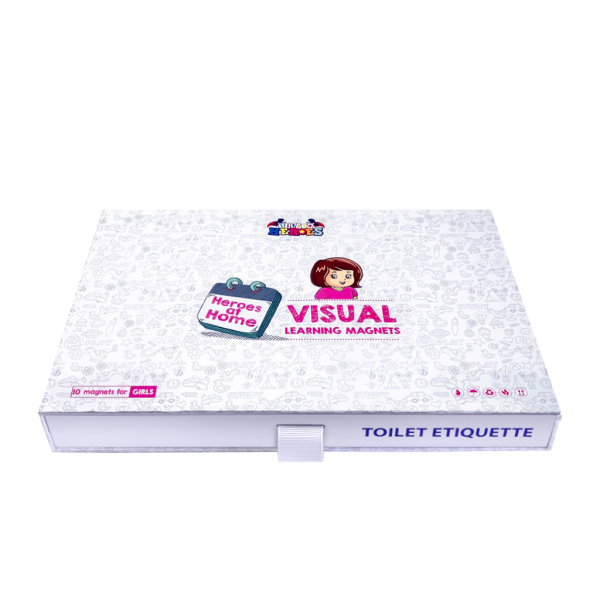"Toilet Etiquette" :Magnet Tiles :Girls
“Toilet Etiquette” (Girls)
A ten card set to teach your little princess healthy bathroom hygiene and habits.
- Pull down underwear
- Pull down shorts/pants
- Sit on the toilet
- Wipe with toilet paper
- Flush the toilet
- Pull up underwear
- Pull up shorts/pants
- Pull up underwear while in dress/ skirt
- Check dress/skirt in the mirror
- Wash hands.
These easy, fun and comprehensive Visual Learning Aids have been carefully designed to help super parents. They will assist your little ones in establishing basic daily routines, while supporting several aspects of their development:
- Establish a daily routine and discipline
- Increase basic vocabulary
- Teach the concept of time (past, present, future)
- Reinforce verbal instructions
- Promote independence
- Task completion and sense of achievement
- Reduce unpredictability, and therefore anxiety
- Prepare for changes in the routine
- Learn the correct order of everyday habits and events
- Improve communication skills
Visual prompts are also exceptionally useful for children with various special needs like ASD (autism), Aspergers, ADHD, ADD, Down syndrome, dyslexia etc., by helping to reduce unpredictability.
Getting started
Before you start working with your child, it is important to keep the following two points in mind:
1. Patience. It might take a few days to a couple of weeks before your little one fully grasps the concept and achieves an interactive learning experience. These things take time even for most adults, when learning something different and new.
2. Keep it simple. When starting out, make sure to begin with a very basic and repetitive schedule like a morning and/or an evening routine; as these are the most consistent and performed daily. Later on, you can start using VLAs throughout the day to help your child through transitions, like changes in the routine.
Sequences and routines
Our sets have up to 12 cards and we recommend you introduce them slowly, over time. Start with one card and follow the action through with your child together with a very basic verbal description, for example: eat. Although the objective is to teach overall comprehension and increase their vocabulary, less is more when you are first starting out.
Allow your child to participate in the creation of a home schedule, even if they get the order all wrong or choose not to “schedule” the steps they dislike. Letting them engage in a playful manner is a first move towards accomplishment. Ultimately the goal is to encourage them to take charge and build their routines independently.
Once your child is well-versed in the basics and responding to simple verbal prompts, you can start using more words to describe the action, such as: eat your breakfast. The same goes for the visual cues themselves. Once your little hero is able to follow and complete a series of one to four steps, without any prompts, then you can gradually increase the number of cards for one task/routine/schedule.











